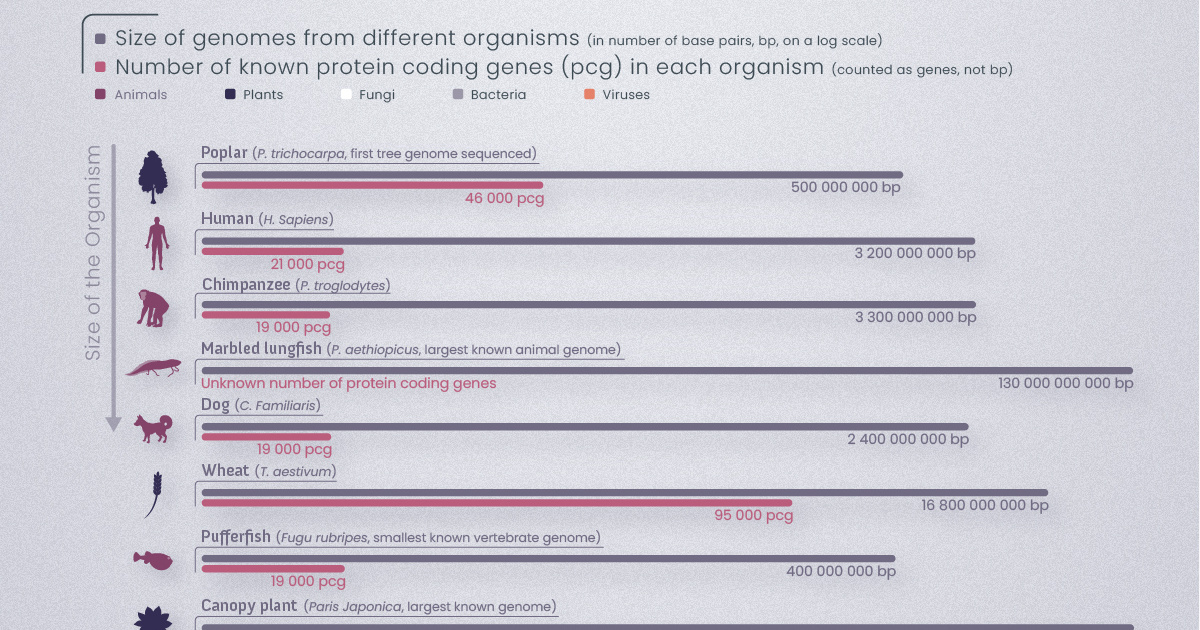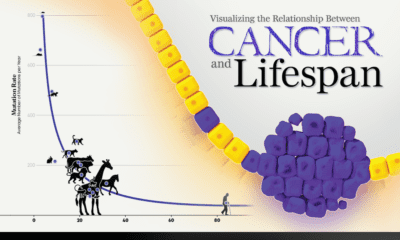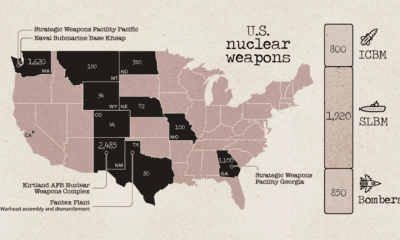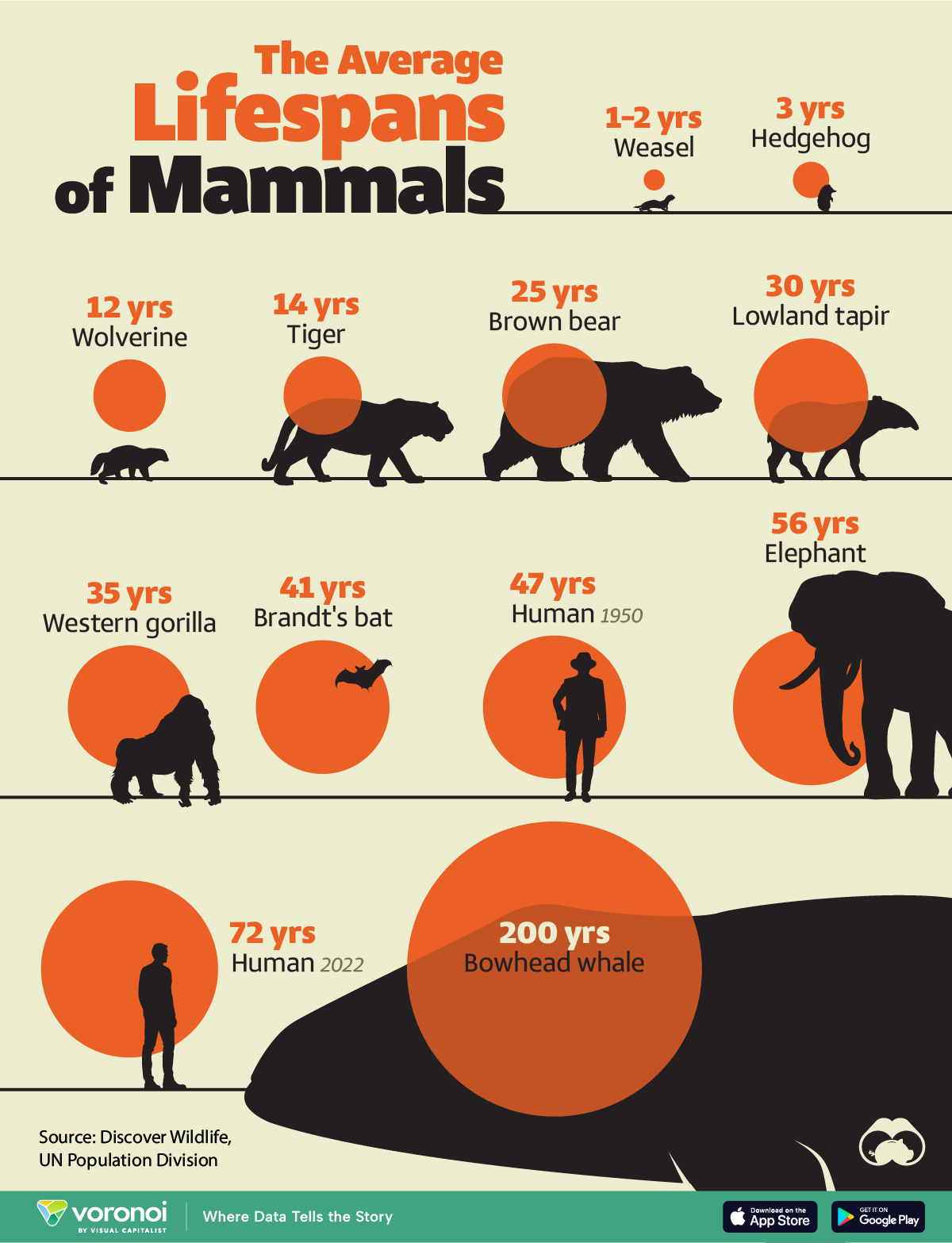Science
Explainer: The Basics of DNA and Genetic Systems

Explainer: The Basics of DNA and Genetic Systems
While there is great diversity among living things, we all have one thing in common—we all rely on a genetic system made up of DNA and/or RNA.
But how do genetic systems work, and to what extent do they vary across species?
This graphic by Anne-Lise Paris explores the basics of DNA and genetic systems, including how they’re structured, and how they differ across species.
Composition of Genetic Systems: DNA and RNA
A genetic system is essentially a set of instructions that dictate our genetic makeup—what we look like and how we interact with our environment.
This set of instructions is stored in nucleic acids, the two main types being deoxyribonucleic acid (DNA) and ribonucleic acid (RNA).
While most living things rely on a mix of DNA and RNA for cellular reproduction, some viruses just use RNA to store their genetic information and replicate faster.
DNA is made up of four molecules, known as nucleotides: Adenine (A), Thymine (T), Cytosine ( C), and Guanine (G). These nucleotides are grouped in sets of two, which are called base pairs.
Size of Genomes Across Different Organisms
Human DNA is made up of approximately 3.2 billion base pairs that are tightly wound up and stored in our cells. If you were to unwind and measure the DNA stored in a single human cell, it would be about 2 meters (6.5 feet) long!
This lengthy DNA is stored in pairs of chromosomes. A full collection of chromosomes, or an entire set of genetic information, is referred to as a genome.
Genomes vary in size, depending on the organism. Here is a look at 24 different species and the size of their genomes, from animals and plants to bacteria and viruses:
| Organism | Kingdom | Size of genomes (number of base pairs) |
|---|---|---|
| Poplar tree | Plant | 500,000,000 |
| Human | Animal | 3,200,000,000 |
| Chimpanzee | Animal | 3,300,000,000 |
| Marbled lungfish | Animal | 130,000,000,000 |
| Dog | Animal | 2,400,000,000 |
| Wheat | Plant | 16,800,000,000 |
| Pufferfish | Animal | 400,000,000 |
| Canopy plant | Plant | 150,000,000,000 |
| Mouse-ear cress | Plant | 140,000,000 |
| Corn | Plant | 2,300,000,000 |
| Mouse | Animal | 2,800,000,000 |
| Moss | Plant | 510,000,000 |
| Fruit Fly | Animal | 140,000,000 |
| C. ruddii | Bacteria | 160,000 |
| S. pombe | Fungi | 13,000,000 |
| S. cerevisiae | Fungi | 12,000,000 |
| S. cellulosum | Bacteria | 13,000,000 |
| H. pylori | Bacteria | 1,700,000 |
| E. coli | Bacteria | 4,600,000 |
| Panadoravirus s. | Virus | 2,800,000 |
| HIV-1 | Virus | 9,700 |
| Influenza A | Virus | 14,000 |
| Bacteriophage | Virus | 49,000 |
| Hepatitis D virus | Virus | 1,700 |
The Marbled Lungfish has the largest known animal genome. Its genome is made up of 130 billion base pairs, which is about 126.8 billion more than the average human genome.
Comparatively, small viruses and bacteria have fewer base pairs. The Hepatitis D virus has only 1,700 base pairs, while E. coli bacteria has 4.6 million. Interestingly, research has not found a link between the size of a species’ genome and the organism’s size or complexity.
In fact, there are still a ton of unanswered questions in the field of genome research. Why do some species have small genomes? Why do some have a ton of redundant DNA? These are still questions being investigated by scientists today.

This article was published as a part of Visual Capitalist's Creator Program, which features data-driven visuals from some of our favorite Creators around the world.
Science
Visualizing the Average Lifespans of Mammals
While smaller animals such as weasels typically live 1-2 years, larger counterparts can thrive for decades.
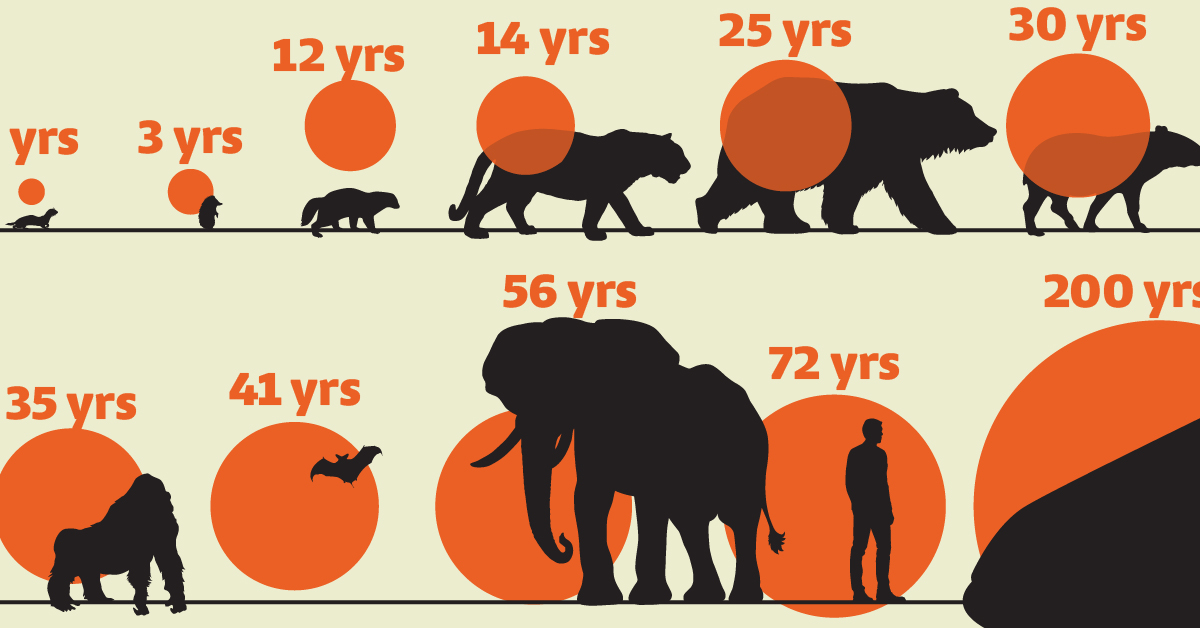
Visualizing the Average Lifespans of Mammals
This was originally posted on our Voronoi app. Download the app for free on iOS or Android and discover incredible data-driven charts from a variety of trusted sources.
Mammals, though comprising a small fraction of Earth’s creatures, hold vital ecological roles globally. They are crucial for maintaining ecosystem health through services like pollination, seed dispersal, and predator-prey dynamics.
In this visualization, we depict the average lifespans of mammals, using data from Discover Wildlife and the United Nations.
Human Lifespans on the Rise
Defined as warm-blooded creatures with hair or fur, mammals nurse their young with milk from mammary glands. While smaller animals such as weasels typically live 1-2 years, larger counterparts like elephants can thrive for decades, and bowhead whales can live for 200 years, or even longer.
| Animal | Average lifespan (years) |
|---|---|
| Weasel | 1 to 2 |
| Hedgehog | 3 |
| Wolverine | 12 |
| Tiger | 14 |
| Brown bear | 25 |
| Lowland tapir | 30 |
| Western gorilla | 35 |
| Brandt's bat | 41 |
| Humans (1950) | 47 |
| Elephant | 56 |
| Humans (2022) | 72 |
| Bowhead whale | 200 |
Notably, human lifespans have experienced a remarkable surge. According to the UN Population Division, the global average life expectancy has surged from 47 years in 1950 to 72 years in 2022, marking a 25-year increase. This is attributed to advancements in nutrition, medication, and essential resources.
However, as human longevity flourishes, it can have an adverse effect on wildlife mammal populations. To put this into numbers, over the past 100,000 years, the surge in human population has precipitated an 85% reduction in wild mammal biomass.
Today, livestock dominates 62% of the world’s mammal biomass, with humans accounting for 34%, while wild mammals comprise only 4%.
Despite a decline in mammal diversity, the total biomass of terrestrial mammals has significantly increased, expanding approximately ninefold over the past 10,000 years.
Curious to learn more about mammals? Check out this graphic that shows the biomass of all the world’s mammals.
-

 Debt1 week ago
Debt1 week agoHow Debt-to-GDP Ratios Have Changed Since 2000
-

 Markets2 weeks ago
Markets2 weeks agoRanked: The World’s Top Flight Routes, by Revenue
-

 Countries2 weeks ago
Countries2 weeks agoPopulation Projections: The World’s 6 Largest Countries in 2075
-

 Markets2 weeks ago
Markets2 weeks agoThe Top 10 States by Real GDP Growth in 2023
-

 Demographics2 weeks ago
Demographics2 weeks agoThe Smallest Gender Wage Gaps in OECD Countries
-

 United States2 weeks ago
United States2 weeks agoWhere U.S. Inflation Hit the Hardest in March 2024
-

 Green2 weeks ago
Green2 weeks agoTop Countries By Forest Growth Since 2001
-

 United States2 weeks ago
United States2 weeks agoRanked: The Largest U.S. Corporations by Number of Employees

